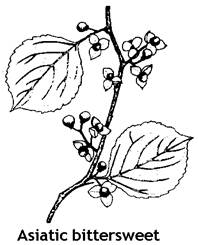– by Bet Zimmerman and Jim Reck, Woodstock Conservation Commission
Drive along East Quasset Road in Woodstock CT, or canoe the Quinebaug, and you will see a woody vine smothering and strangling many tall trees. It is probably Asiatic or Oriental bittersweet (Celastrus orbiculatus Thunb.) This invasive, out of control ornamental was brought the U.S. from China around 1860, and has been in Connecticut for at least 90 years.
Oriental Bittersweet is spread by birds (which is why you see it along fencerows/road edges where they perch), water (the fruit floats) and humans (planting, or carelessly tossing it out in wreaths or floral arrangements.) Because it is such a huge problem, its sale in CT has been banned since 2004.
Like other invasive plants, Oriental bittersweet is aggressive and spreads rapidly. It prefers sunny areas, but tolerates partial shade. It will climb 60 feet high and the vines can grow as thick as your wrist. It will shade out, strangle or girdle other plants. The overwhelming weight of the tangled vines can break branches or bring down entire trees. It can also impact forest re-generation. Don’t confuse it with the benign, native American bittersweet (Celastrus scandens L.) The easiest way to tell them apart is by the location of the fruit. It’s harder to distinguish them by fruit color, which can vary.
| Species | Leaf Shape | Ripe Fruit | FRUIT LOCATION | Leaves |
| Oriental/Asiatic bittersweet (bad) |
 |
More color contrast – bright yellow with showy orange/red fruit | Along the length of stems | Generally rounded |
| American bittersweet (good) |  |
Darker orange inside, paler orange outside | Only on ends of major branches or vines | Generally narrow, pointed |
It is suspected that Oriental bittersweet might hybridize with native bittersweet, which makes it an even bigger threat. Oriental bittersweet is not easy to get rid of it, but if you don’t deal with it, it will smother everything it touches and spread into an impenetrable mess. Some sources recommend pulling up small, individual vines by the roots, but this is really hard, as it is quite tenacious. New shoots will sprout from missed roots. Forget just cutting it back – it seems to enjoy that. Burning isn’t recommended, and comes with the risk of forest fires.
That leaves “Better Living through Chemistry.” Cut the vines back, and immediately spot treat the stems or stumps with undiluted Brush-B-Gon (8%). Use a squirt bottle to spot treat the cut stumps, or wipe or paint it on each stump with a sponge. Brush-B-Gon is more effective than Roundup on this woody vine. For large populations, foliage can be sprayed during active growth with Brush-B-Gon (4 oz/gallon of 8% strength) using a backpack sprayer, but this doesn’t work as well as the stump treatment.
Herbicides work best when temperatures are still warm enough that targeted plants are actively growing. The best time to do this is late summer or early fall. If you try to use them in cooler temperatures, you might as well pour water on the weeds. Make sure you don’t hit non-target plants, as all of these herbicides will kill other plants. Of course, when using any pesticide, follow all instructions on the label.
Since Oriental bittersweet produces a lot of seeds, and roots can re-sprout, you’ll need to stay with it for at least two years running. The good news is that you’ll have far less to deal with in subsequent years. One approach that might help with re-growth in small areas is covering the area with heavy cardboard. You might be able to get some from an appliance store. Then mulch with leaves, grass clippings, etc. on top of the cardboard. Another is introducing other plants that will compete with the Oriental bittersweet when it tries to come back. Always go with plants that are not banned or listed as invasive. Two native alternatives that will spice up your landscape are:
- Dutchman’s Pipe (Aristolochia durior). With support, this vine can reach to 30 ‘. It’s a great plant for screening, with creamy white flowers that resemble a pipe.
- Trumpet Vine (Campsis radicans). Hummingbirds can’t resist the large bright flowers on this aggressive climber. The red/orange varieties are a bit hardier here than the yellow-flowered form.
Three million acres are lost each year in the U.S. to invasive plants. Don’t let them take over your property. The sooner you tackle them, the easier and more effective it will be. For more information, see http://www.woodstockconservation.org.
Special thanks to Donna Ellis, Extension Educator with the University of Connecticut for her input.

